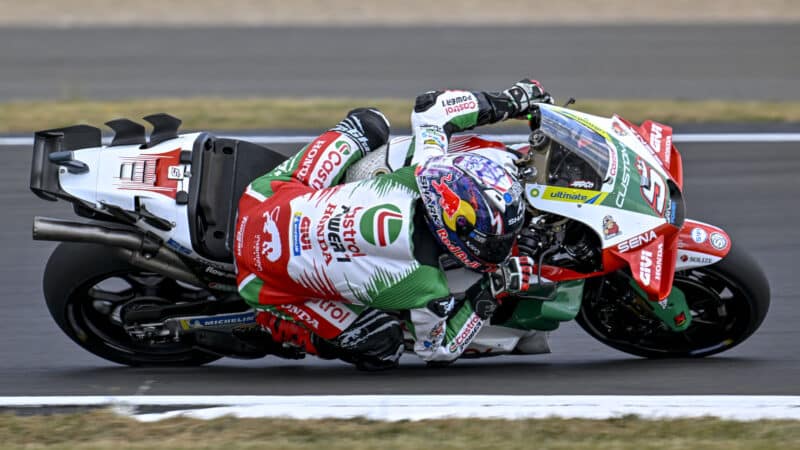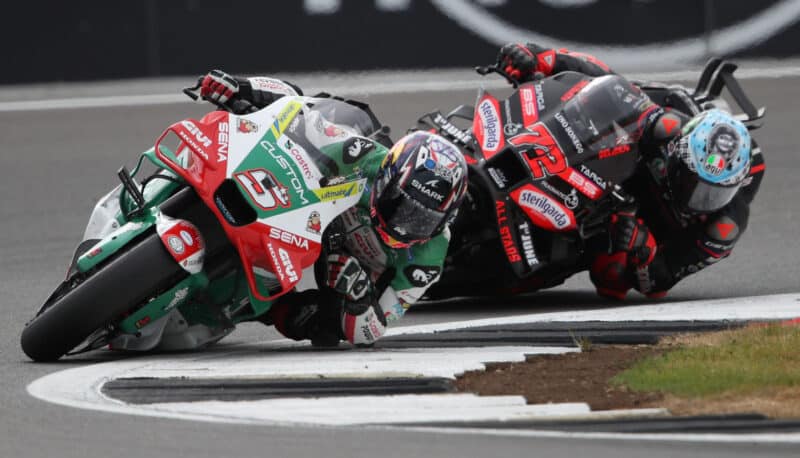How Honda made its MotoGP bike fast again
HRC's new technical director Roman Albesiano talks upgrades, his university dreams of motorcycle racing with ground effect, next month's first Pirelli tests and how the 2027 rules changes will make MotoGP "a totally different category"

Zarco rides to second place at Silverstone – the RC13V uses downforce aero inspired by Aprilia and Ducati. That’s how MotoGP works: copy, then try to improve
LCR
Honda has had such a difficult time in the last half-decade of MotoGP that it’s easy to forget that the Japanese brand is MotoGP’s most successful manufacturer of all time, with 314 premier-class victories, from May 1966 to last month’s French Grand Prix, and 46 riders and constructors’ championships.
In 2019, when Marc Márquez was at his peak, Honda won 12 GPs. In the five-and-a-bit years since, it’s won five GPs and finished at the bottom of the last three constructors’ championships. No surprise there were rumours that Honda might quit the series that it’s been part of for more than half a century.
Instead, Honda upped its commitment – there are more HRC (Honda Racing Corporation) engineers in the paddock now than ever before – and hired Aprilia chief engineer Romano Albesiano as its technical director. Only a few years ago it would’ve been unimaginable for a European to lead Japan’s greatest racing department, but times change and companies need to adapt to those changing times.
Honda’s stunning return to form – victory at Le Mans and second place at Silverstone – isn’t all down to Albesiano but there’s no doubt that Honda has hired someone who knows how to get ahead in MotoGP’s new technological age.
Unlike most senior MotoGP engineers, Albesiano didn’t study mechanical or electronic engineering at university, he studied aerodynamics, dreaming of using ground-effect aero on grand prix bikes. During the 1990s he worked as a chassis engineer on Cagiva’s 500cc GP project, then moved to the AMG Mercedes DTM project, where he worked on aerodynamics before joining Aprilia.
HRC technical director Albesiano [right] watches Silverstone practice with HRC colleagues
Mat Oxley
![HRC technical director Albesiano [right] watches Silverstone practice with HRC colleagues](https://motorsportmagazine.b-cdn.net/wp-content/uploads/2025/06/oxley2-800x450.jpg)
RA: Some improvements came from the engine’s torque-delivery character which the riders appreciate a lot. Then we had some improvements in electronics strategies, especially traction control. Also, the bike is quite different in terms of bike set-up, especially in the braking and wheelie phases.
In general, this year’s bike isn’t much different from last year’s, so the riders haven’t needed to adapt to something new, and this always pays.
Presumably, as the gap gets smaller you can focus more and more on the details?
The first rule is to understand where the gap is. This is always the focus. Maybe it’s different from rider to rider, but now we are in a phase where the gap isn’t big, so it’s related to the motorcycle, of course, but also to each rider. So on one side, it’s becoming more complicated, because it’s specialised for each rider, but this is still the key – to understand where you are losing, then try to recover or compensate with other phases.
What’s next, another new engine spec or other upgrades for next week’s Aragon tests?
Yes, there are new things coming. A new engine spec, not very soon but it will come. Also aero and many other things. I’d say that the complete bike is in a state of evolution, but not revolution.
The right kind of torque delivery is so important to help riders exit corners well, but nowadays maybe negative torque [engine-braking] is even more important for entering corners, because riders use the rear tyre much more in this phase?
Yes, much more than in the past. Controlling the engine-brake phase is super-important and super-difficult. Maybe it’s the most difficult and challenging job for track engineers and electronics engineers to have an accurate and consistent level of engine brake, according to what the rear tyre can accept. Also the rider plays a part, because braking with the rear tyre is made of human control and automatic control [engine-brake software), so the two components have to be balanced in a correct way.

Zarco leads British GP winner Marco Bezzecchi. Note the RC213V’s ground-effect bulges which are very close and parallel to the road. This increases air speed, which creates an area of low pressure, which has the higher pressure above the bike push the bike – and the tyres – into the asphalt for more grip
This must be really interesting…
Maybe less exciting than finding more horsepower and things like that! But even more important for the lap time.
Obviously Honda enjoys a lot of success in Formula 1 [Red Bull used Honda powertrains] and Honda’s F1 and MotoGP projects now exist under the same HRC banner, so do you have access to that powertrain know-how?
You have to consider that the technology of current MotoGP engines is the same technology of F1 engines at the beginning of the 2000s, when F1 engines were naturally aspirated [not turbocharged], so the issues that current F1 engines face are totally different. So it’s not, let’s say, obvious to get direct feedback from F1, but anyway this kind of communication does exist.
Aleix Espargaró [Honda’s chief MotoGP test rider] told us that the RC213V’s current performance comes from using lots of existing parts and putting them together in the right sequence. This sounds like a 3D jigsaw puzzle, so how do you solve that puzzle, with rider feedback, data, AI or what?
It’s a mix of three kinds of information, and the most important is always the stopwatch. It’s difficult to say which comes second, between rider comments and data. Actually, it’s becoming more data than rider comments, but it still depends.
Presumably, one reason data is becoming more important is that the differences between one part and another can be so tiny that the rider can’t feel the difference, especially with aerodynamics, where ride feeling and lap time can disagree?
Data analysis is becoming more and more important and crucial. Many times we get negative comments from riders and when we look at the data we see the opposite. This isn’t because the riders are no good at giving feedback but often we see that the bike which is nice to ride isn’t faster.

Luca Marini, currently recovering from a nasty smash during testing for the Suzuka 8 Hour, is Honda’s second best-placed MotoGP rider
Recently an engineer from another MotoGP manufacturer told me that any info that isn’t actual data is just opinion. Would you agree with that?
Partially! Because more and more you can see many things from the data. But in the end the rider is fast when the bike gives him confidence. If the rider doesn’t have that confidence you can tell him that the data says the bike is good, but it’s the stopwatch that decides.
So the bike needs to be good but most of all the rider needs the confidence to keep pushing to the limit and beyond…
You could probably build a bike which your computer simulations say will be half a second faster, but when you give that bike to the rider it will be two seconds slower.
Back in 1990s, when you were at Cagiva, European engineers had to learn to think like the Japanese. I remember Cagiva project leader Riccardo Rosa travelling to Japan to visit Mikuni [carburettors], Showa [suspension], Yamaha and so on. Now it’s the complete opposite, so Japanese engineers need to think like Europe. Do you recognise this shift, because, after all, you are the evidence?!
Yes, it’s quite evident! I remember the time of 500 GPs when there were only two factories producing carburettors for the four-cylinder two-strokes – Mikuni and Keihin – and if you didn’t have their stuff, you couldn’t get anywhere. And it was the same for ignition, radiators, ignition…
Many things have changed, maybe because the Japanese focused more on mass production, while racing suppliers in Europe grew up. European manufacturers have invested a lot in racing, so things have changed a lot.

HRC test rider Espargaro and crew during the British GP
Much of the recent changes in MotoGP technology come from engineers reading the rules like F1 engineers read the rules, so they are reading between the lines, looking for gaps…
This is clearly a culture from F1, developed in Europe, in the slipstream of F1. Also, it’s Japanese culture to stick to the rules, whereas it’s more of a European attitude to try to bypass the rules! [Laughs]
How does it work at HRC – who do you report to?
I currently report to Yuzuru Ishikawa and I’m working strictly with the development department. We were at HRC last week. It’s not easy because I’m far from them, but I’m leading the direction of development, like I was doing at Aprilia. Of course, here it’s more complicated because of the distance, but I’m doing more or less the same job I was doing at Aprilia.
So you’re going to Japan once a month, as well as attending 22 MotoGP rounds and various tests?
Yes – you get used to almost everything!
How does HRC at Asaka compare to the Aprilia race department at Noale?
It’s different but there are some similarities. You feel the size and the resources and you feel the passion. They may show it differently but it’s the same passion. The organisation is a little bit different but I cannot go into too much detail. Sorry.
Now that CFD [Computational Fluid Dynamics] software is so good, do you do most of your aerodynamics work in CFD?
I think all manufacturers also do wind tunnel testing with the bike in the straight-up position, the roll position, everything. You always start in CFD and then you use the wind tunnel to confirm things. You can do more and more in CFD, because you can do thousands of experiments and it’s much faster, but it’s not always obvious to get confirmation [from real life].
You are different from most MotoGP engineers, so do you see bikes more from a downforce/ground-effect point of view?
Ground effect on racing motorcycles is something I was dreaming about when I was at university! But you have to have a general view of the motorcycle. In recent years there’s been lots of talk about aerodynamics – aerodynamics is important but maybe less important than the amount of talk about it.

